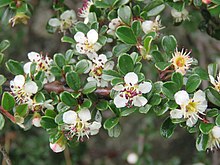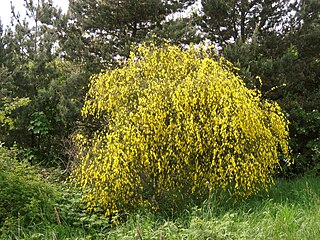
A shrub is a small-to-medium-sized perennial woody plant. Unlike herbaceous plants, shrubs have persistent woody stems above the ground. Shrubs can be either deciduous or evergreen. They are distinguished from trees by their multiple stems and shorter height, less than 6–10 m (20–33 ft) tall. Small shrubs, less than 2 m (6.6 ft) tall are sometimes termed as subshrubs. Many botanical groups have species that are shrubs, and others that are trees and herbaceous plants instead.

Mahonia is a genus of approximately 70 species of evergreen shrubs and, rarely, small trees in the family Berberidaceae, native to eastern Asia, the Himalaya, North and Central America. They are closely related to the genus Berberis and botanists disagree on whether to recognize a separate Mahonia. Many botanists prefer to classify Mahonia as a part of Berberis because several species in both genera are able to hybridize, and because there are no consistent morphological differences between the two groups other than the leaf pinnation. However, recent DNA-based phylogenetic studies retain the two separate genera, by clarifying that unifoliolate-leaved Berberis s.s. is derived from within a paraphyletic group of shrubs bearing imparipinnate evergreen leaves, which are then divided into three genera: Mahonia, Alloberberis, and Moranothamnus ; a broadly-circumscribed Berberis would also be monophyletic.

Grevillea, commonly known as spider flowers, is a genus of about 360 species of evergreen flowering plants in the family Proteaceae. Plants in the genus Grevillea are shrubs, rarely trees, with the leaves arranged alternately along the branches, the flowers zygomorphic, arranged in racemes at the ends of branchlets, and the fruit a follicle that splits down one side only, releasing one or two seeds.

Cotoneaster is a genus of flowering plants in the rose family, Rosaceae, native to the Palaearctic region, with a strong concentration of diversity in the genus in the mountains of southwestern China and the Himalayas. They are related to hawthorns (Crataegus), firethorns (Pyracantha), photinias (Photinia), and rowans (Sorbus).

Cotoneaster franchetii is a species of Cotoneaster native to southwestern China, in the provinces of Guizhou, Sichuan, Tibet, and Yunnan, and also in adjacent northern Myanmar and northern Thailand.

Cotoneaster cambricus is a species of Cotoneaster endemic to the Great Orme peninsula in north Wales. It is the only species of Cotoneaster native to the British Isles. It has never been found naturally at any other location. In the past, it was included within the widespread eastern European Cotoneaster integerrimus, but differs from that in genetic profile.

Liparis, commonly known as widelip orchids, sphinx orchids or 羊耳蒜属 is a cosmopolitan genus of more than 350 species of orchids in the family Orchidaceae. Plants in this genus are terrestrial, lithophytic or epiphytic herbs with a wide range of forms. The flowers are usually resupinate and small to medium sized, yellow, yellow-green or purplish with spreading sepals and petals. The labellum is usually larger than the sepals and petals and is lobed, sometimes with a toothed or wavy margin and one or two calli at its base.
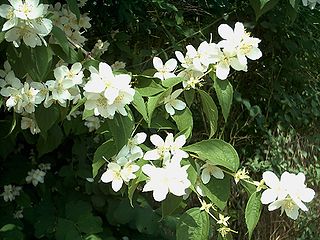
Philadelphus coronarius is a species of flowering plant in the family Hydrangaceae, native to Southern Europe.
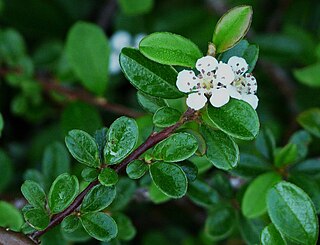
Cotoneaster dammeri, the bearberry cotoneaster, is a species of flowering plant in the genus Cotoneaster, belonging to the family Rosaceae, native to central and southern China and naturalized in Europe.
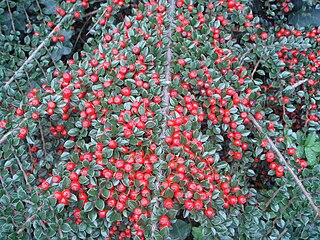
Cotoneaster atropurpureus, the purple-flowered cotoneaster, is a species of flowering plant in the genus Cotoneaster of the family Rosaceae, native to the Hubei province of China. It is a prostrate, deciduous shrub growing to 2.5 metres wide. It can be used as groundcover or trained to ascend up a wall or other support. Its fan-shaped, arching branches bear small, rounded, glossy green leaves turning purple in autumn. Red/black flowers are followed by small, globose, scarlet fruits (pomes).

Cotoneaster frigidus, the tree cotoneaster, is a species of flowering plant in the genus Cotoneaster of the family Rosaceae, native to the Himalayas. It is a deciduous tree or shrub growing to 10 metres (33 ft). White flowers are followed by masses of small, globose, red fruits (pomes) in autumn, persisting into winter if not eaten by birds.
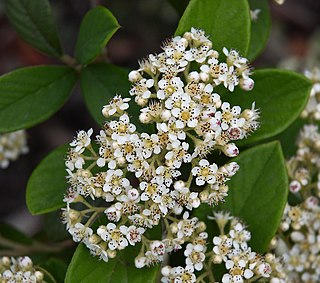
Cotoneaster lacteus, the late cotoneaster or milkflower cotoneaster, is a species of flowering plant in the genus Cotoneaster of the family Rosaceae, native to the Yunnan Province of China. It is a large evergreen shrub growing to 4 m (13 ft) tall and wide. Clusters of white flowers are followed by masses of small, globose, red fruits (pomes) in autumn. Unusually for this genus, the fruits are avoided by birds, hence garden escapes are rare, and the fruit persists on the plant throughout the winter.

Cotoneaster acuminatus, commonly known as acuminate cotoneaster, is a species of flowering plant in the family Rosaceae that is native to the Himalayas. In forests it can be found at elevations of 1,300–3,000 metres (4,300–9,800 ft), while on hillsides it is found at 2,500–3,500 metres (8,200–11,500 ft). The species has also been introduced to Oregon.
Cotoneaster granatensis is a species of flowering plant in the family Rosaceae that can be found in Algeria, Morocco, Spain and Tunisia. It was described in 1836.

Cotoneaster simonsii, the Himalyan cotoneaster, is a species of flowering plant in the family Rosaceae. It is native to Nepal, the eastern Himalayas, Assam, and Myanmar, and has been introduced to a number of locales in Europe, the west coast of North America, and Australia as a garden escapee. The Royal Horticultural Society considers it to be an undesirable invasive non-native species.

Diurideae is a tribe of orchid in the subfamily Orchidoideae. It contains about 40 accepted genera. As of April 2018, its division into subtribes remained unclear.

Cotoneaster conspicuus is a slow-growing, densely-branched, evergreen shrub native to southeast Tibet. It grows to 1 to 1.5 meters in height, with white five-stellate flowers followed by scarlet fruit, 8–10 mm in diameter.

Acacia calamifolia, commonly known as wallowa or reed-leaf wattle, is a shrub or tree belonging to the genus Acacia and the subgenus Phyllodineae endemic to south eastern parts of Australia.

Pomaderris cotoneaster, commonly known as cotoneaster pomaderris, is a species of flowering plant in the family Rhamnaceae and is endemic to south-eastern continental Australia. It is an erect shrub with woolly-hairy stems, elliptic leaves, and leafy panicles of cream-coloured flowers.
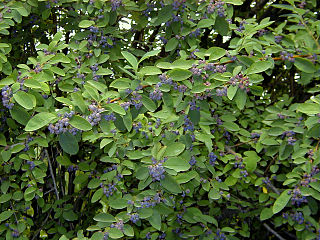
Cotoneaster acutifolius, the Peking cotoneaster, is a species of flowering plant in the family Rosaceae. It is native to southern Siberia, Mongolia, and most of China, and it has been introduced to Canada, the northern United States, and northern Europe. It is a shrub typically 2–4 m (7–13 ft) tall, found in a wide variety of habitats. Some authorities consider Cotoneaster lucidus, the shiny cotoneaster, to be a synonym of Cotoneaster acutifolius.
